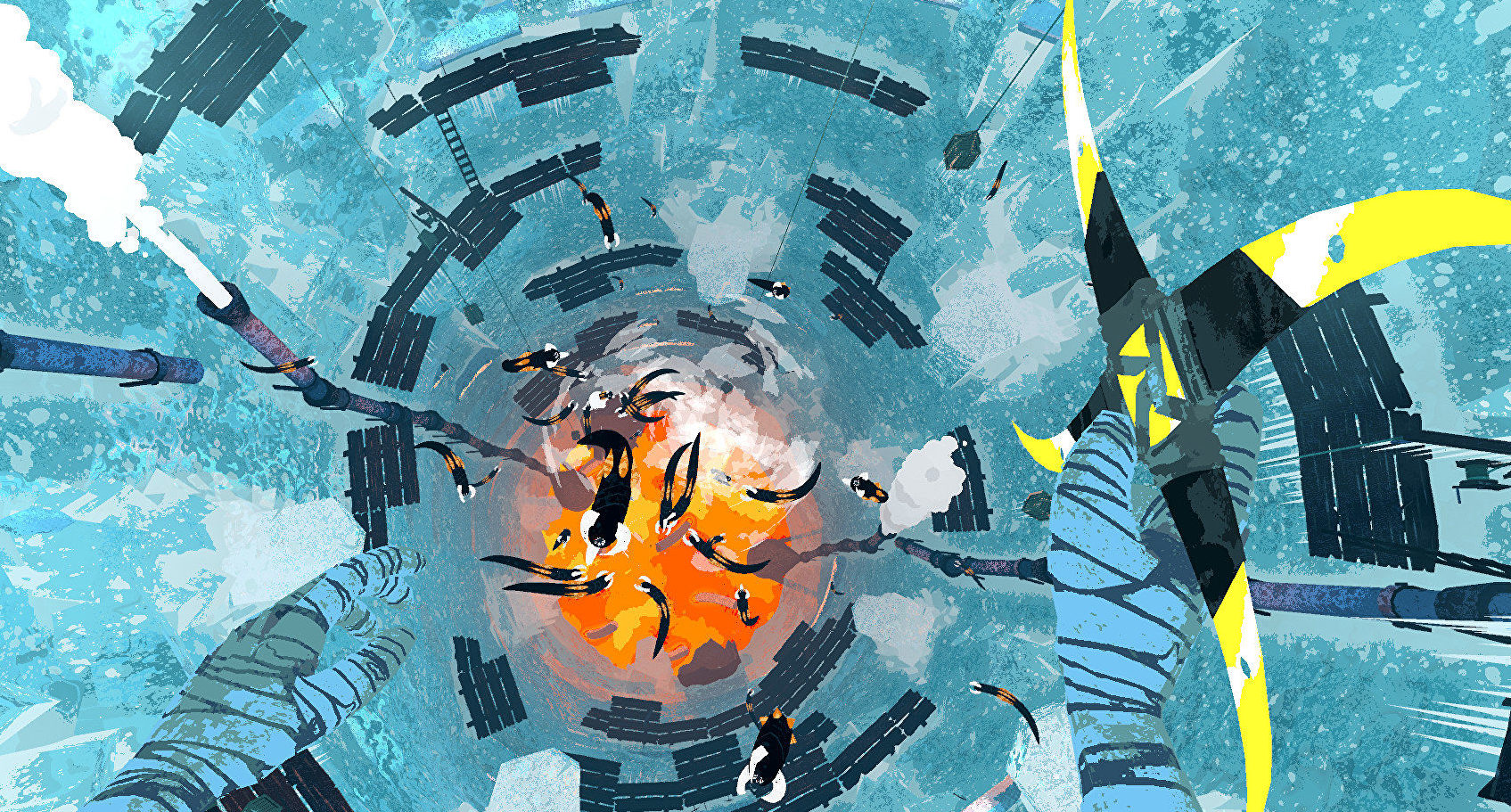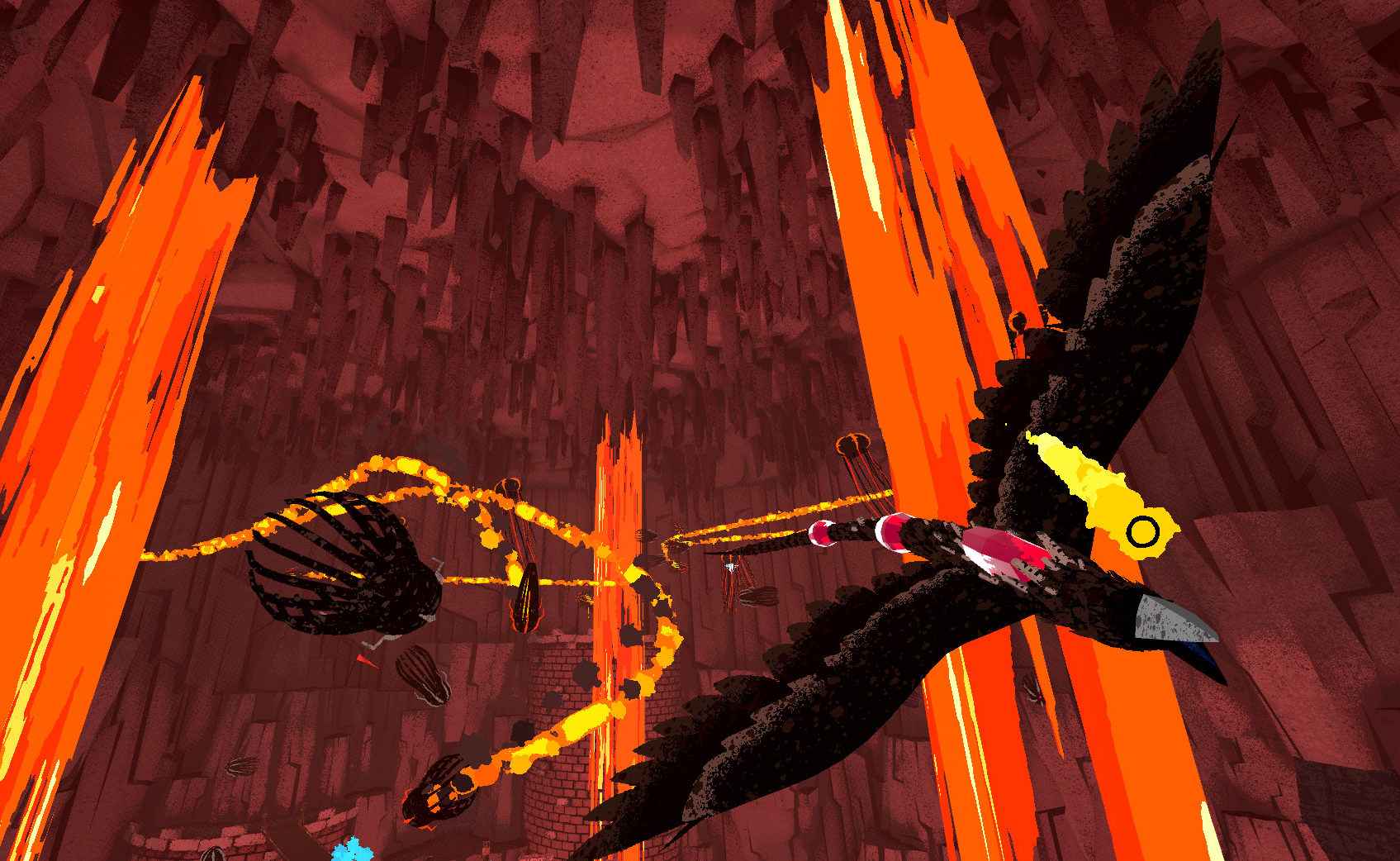Platforms:
PC, Nintendo Switch
Released:
July 8, 2021
Publisher:
Devolver Digital
Developer:
DANG!
Boomerang X is a title that is very simple and very focused in its approach. Coming to us from indie studio DANG! and publishing label Devovler Digital, this first-person “boomeranger” plays out like an arena shooter, albeit with a uniquely stylised weapon of choice. A huge amount of work and effort has gone into polishing the moment-to-moment gameplay of Boomerang X to a mirror shine. The small-scale experience is fantastic. However, in keeping that focus, a lot of the traditional large-scale loops have been brushed to the side.
Gameplay basics – A sharp focus
Boomerang X really fits the quintessential Devolver indie experience style, with a tight focus on the mechanical guts. From the outset, everything is quite straightforward in its design. You have a boomerang, you have bad guys, and you get to introduce the two frequently. As such the game reads as a sort of minimalised first-person shooter experience. Aim, throw, kill, catch your boomerang, and let the cycle begin anew. This is in essence the micro-loop this game runs on, albeit one that changes as new elements are brought into the mix.
“you’re really falling into a whole Matrix or Superhot style ‘bullet-time hyper-precision’ flow state”
There’s a very straightforward familiarity to the design too. The bad guys are clad in black fur and skin with the occasional white accent. Anything you might need to aim for, a switch for a door or an enemy weak point for example, has a glowing ruby crystal effect on it. It affords the game this purity and intuitiveness to its design. This allows the tutorial to be a bit of a light touch. The focus is more on just getting the tools into the player’s hands, giving them room to test it out, but otherwise leaving the player to integrate the new elements into combat on their own.
The powers – on the bleeding edge
The real draw for me in this game is the powers. At the very start of the game, all you do is awkwardly walk around, mashing attacks at enemies. This stage of the game is not really all that fun. You’re constantly stuck on the back foot and feel a bit underpowered. There’s no verticality or evasive capabilities either. That might not seem like a deal-breaker, but this is a first-person game where you can easily be surrounded. Subsequently, the first few levels feel paradoxically both unnecessarily tense and needlessly slow.

Boomerang X really starts turning the corner with the inclusion of the Slingshot power. In short, you pull yourself towards the boomerang once it’s thrown, catapulting you across a level with all the momentum that comes with it. It totally plugs you into the adrenaline rush you’d get when you first drop multiple stories into a portal, it’s such a fun addition. Having said that, this mechanic does overcorrect the speed issue, leading to levels where you’re now wildly flinging around. So I’d say until you additionally get Flux, an ability to slow time, you haven’t really hit the sweet spot for the gameplay. At that point, you’re really falling into a whole Matrix or Superhot style “bullet-time hyper-precision” flow state and it’s awesome.
The game does add extras on top of the aforementioned powers including alternate fires, which are just a bonus and give you a bigger palette of choices. Ultimately though, the powers that the game gives you are fantastic in due time, but I would have preferred them sooner. I understand the drip-feeding might help new players slowly take the reins, but honestly, I’d prefer a little bit more hustle in the early stages. Especially given that by the time you reach the ‘butter zone’, you’re already a good distance into the game’s campaign. By this stage, they’re really throwing the kind of enemies at you that demand you use the powers to the best of your ability.
Waves of enemies – Spinning in their graves
From the microscopic loops of the mechanics, we can zoom out to the individual levels. Each combat level is broken up into waves, usually a half dozen or so. Each wave in turn has 2-12 “objective enemies”. Basically, while there may be dozens of enemies, only specific ones need to be taken out to finish a wave. It’s an interesting choice, as it does give you the opportunity to completely ignore some foes. This can be an interesting decision to make and allows for on-the-fly strategic choices.
In lieu of a health bar, Boomerang X has shields. Every bit of damage inflicted upon the player knocks off shields, which can be replenished at shield recharge points. Progressing through the story, players get more shields to play with, plus a power that, when charged, can deal damage when you hit an enemy. All this is to say that there is a good relationship between the game’s escalating challenge and the resources you receive. Theoretically, this makes for a good system for the game. In practice, however, with all the chaos surrounding the game, recharging becomes bloody hard. It can be difficult to platform precisely in this game when also juggling slow time to be able to keep enemies in check. Furthermore, this is very much that flavour of game where you have to keep moving or you take damage. Staying in one place, say for example a shield recharge pad, could make you lose more shields than you gain. It’s the kind of system where you have to plan out shield recharge at the end of a wave. Perhaps the pads are more of a mousetrap. Either way, my prevailing emotion regarding the pads is that of frustration. Boomerang X’s combat and platforming are a bit too dissonant for the pads to be anything but bait on the hook, especially with all the enemies being thrown at you.

I must say, as the game progressed, Boomerang X showed off some great enemy concepts. Electric eels swim through the air and as enough congregate, sparks fly until an electric orb explodes between them. Floating eyeballs cast death lasers that slice across entire maps. Teleporting wizards generate globules of poison, gradually forming a minefield of floating green droplets. This is not to say that all enemies are as great. A moth has an expanding column of light that can very easily disorient you and drain you of all your shields in quick succession. Thunderstorms forming from a giraffe-like creature are a double whammy: a rather large area of effect, with unclear damage-dealing properties. In both cases, I learned how to deal with them through trial and error. It’s not ridiculously hard to learn how to defeat them. In a sense, it even somewhat adds to the experience. However, I think the real reason I disliked them is that they killed me, halted my progression, and caused frustrations. At times the game would demand such focus from me it’d make my eyes sting.
Regarding narrative – vicious circle
The largest loop of any game is so big it doesn’t even give us the full circle, it’s the arc. Boomerang X has a weird relationship with narrative. It’s clear at points that the developers are flirting with the concept. The character wakes up on an island and seemingly escapes from it. There is a dialogue between a secondary character, but they have maybe half a dozen lines scattered across two isolated encounters. It’s this surreal experience that makes me wonder if I somehow missed something. Like maybe it’s too high concept, or maybe I just didn’t get more dialogue lines because I missed them, or I didn’t earn them? I really don’t know. It’s odd.

The lack of a defined plot aside, I want to talk about a narrative of a different kind. See, I appreciate that this is the kind of game for which the story is at best going to be a light touch. The problem is I want to see some reflection of a plot in the gameplay. For Boomerang X, there is a hint of that. The difficulty curve synchronises well with the aforementioned enemy design and growing power set. Be that as it may, there needs to be a bit more. What I want from this game is some kind of mechanical arc as a story, a ludological narrative if you will. I’m thinking on the level of say, distinct biomes and regular boss fights. In theory, there is some element of the environment being part of the story. In practice, the environmental storytelling is just going further underground, so the aesthetic variety dwindles over time.
“Boomerang X has a weird relationship with narrative.”
Boss fights work a little better. A frog that projectile vomits green slime around the room and the giant saw blade are two examples that do manage to spice up their respective encounters. I do have to append an asterisk though that these are still presented as enemies in the multiple wave model, so that does undercut my enthusiasm. I feel like they would be more exciting as a boss fight in and of themselves. Although with that said, the one ‘true’ boss fight in the game wasn’t actually to my tastes.
At the very end of the game, Boomerang X has one last little boss fight. I appreciate the thought, and I want to commend the developer for including it. But I’d be lying if I said it didn’t irk me in some ways. Of course, the boss fight is a dramatic multi-stage affair, which reads off a different page to the frenetic kill upon kill upon kill nature of the main game. My issue is more that it seems to be intentionally designed to make traversal needlessly difficult. Without spoiling too much, the arena’s ill-defined boundaries and disorienting platforms made for an unfortunately taxing experience.
7
Good
Positive:
- The skills, especially Slingshot and Flux, are absolutely fantastic
- Exciting and captivating gameplay loop
- Gameplay mechanics are polished to a mirror shine
- Compelling enemy design
Negative:
- Starts a bit slow
- No campaign arc and wave structure make the game feel repetitive
- Shield pads cause frustration
Boomerang X is truly a spiral of interlocking gameplay loops stacked on top of each other. After a slow start, Boomerang X whips up an absolute whirlwind of bullet-time style combat that can be an absolute sight to behold. So much love and care have clearly permeated the gameplay of this title. The problem is that beyond the loop, there isn’t a lot going on. Some frustrating design elements and a feeling of repetition is present, although it doesn’t fully dampen what is undoubtedly some fantastic moment-to-moment gameplay.





